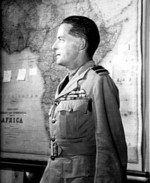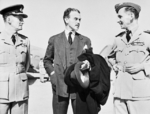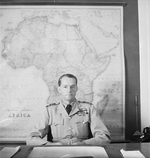![Peter Drummond file photo [29636] Peter Drummond file photo [29636]](/images/5e2366f849acb.jpg)
Peter Drummond
| Surname | Drummond |
| Given Name | Peter |
| Born | 2 Jun 1894 |
| Died | 27 Mar 1945 |
| Country | Australia, United Kingdom |
| Category | Military-Air |
| Gender | Male |
Contributor: C. Peter Chen
ww2dbaseRoy Maxwell Drummond was born in Perth, Australia in 1894 to merchant John Maxwell Drummond and Caroline Drummond (née Lockhart). While studying at Scotch College in Melbourne, Australia, he acquired the nickname "Peter"; later in his life, in 1943, he would formally take on Peter as his legal first name. In 1914, he enlisted in the Australian Imperial Force. Judged too weakly built for the infantry, he was assigned to the 2nd Stationary Hospital of the Australian Army Medical Corps as an orderly. With his unit, Corporal Drummond departed Australia for Egypt in Dec 1914. He served aboard a hospital ship off Gallipoli in Apr 1915. In Dec 1915, while in England, United Kingdom recovering from dysentery, he requested for a transfer to the British Royal Flying Corps. Accepted, he was discharged from the Army in Apr 1916. Upon the completion of flight training, he was given the rank of temporary second lieutenant and was assigned to No. 1 Squadron of Australian Flying Corps (also known as No. 67 Squadron RFC) based in Egypt. In Apr 1917, he was awarded the Military Cross medal for, together with Lieutenant Adrian Cole, drove off six enemy aircraft that were attempting to bomb Allied cavalry. In the following month, he was promoted to the rank of temporary lieutenant. In Oct 1917, he was promoted to the rank of temporary captain and was transferred to No. 111 Squadron RFC. For various acts of gallantry, he was awarded the Distinguished Service Order medal, with Bar, during WW1. He scored eight victories during WW1. In Jul 1918, after the creation of the Royal Air Force, he was given command of No. 145 Squadron RAF. In Aug 1919, he was promoted to the rank of captain. Between Jan and Jul 1920, he served in British Sudan. In Jul 1921, he was made an Officer of the Order of the British Empire. Between 1922 and 1923, he studied at the RAF Staff College, Andover. In Jan 1923, he was promoted to the rank of squadron leader. Later in 1923, he proposed an officer exchange scheme for the RAF and the newly formed Royal Australian Air Force. In 1924, he served with the Air Ministry. In 1925, he was transferred to the RAAF, where he served as the Director of Operations and Intelligence at Air Force Headquarters in Melbourne, Australia until 1929. In Jul 1929, he married Isabel Drake-Brockman, cousin of Brigadier General Edmund Drake-Brockman, at St John's Anglican Church in Toorak, Victoria, Australia; they would have a son and two daughters together. In Nov 1929, he returned to the United Kingdom. In 1930, he studied at the Imperial Defence College, London. In Jul 1931, he was promoted to the rank of wing commander. Between Nov 1931 and Jun 1933, he was the commanding officer of the fighter base RAF Tangmere. Then, until mid-1936, he was attached to the Air Ministry. In Sep 1936, he was made the commanding officer of RAF Northolt. In Jan 1937, he was promoted to the rank of group captain. In Nov 1937, he was made the senior air staff officer at RAF Middle East in Cairo, Egypt. In Jul 1939, he was promoted to the rank of air commodore.
ww2dbaseWhen the United Kingdom declared war on Germany in Sep 1939, Drummond was still at Cairo. In early 1940, he was involved in the Anglo-French plans for bombing Soviet oil fields in the Caucasus (Operation Pike). Then, he led a delegation at Aleppo, Syria-Lebanon to discuss the defense of a possible invasion of Turkey by either Germany or the Soviet Union, and the deployment of Operation Pike units in Syria. In Jun 1940, he was promoted to the rank of air vice-marshal; in Jan 1941, he was made a temporary air vice-marshal. In Jun 1941, he was promoted to the rank of acting air marshal and was made Deputy Air Officer Commander-in-Chief of RAF Middle East under Arthur Tedder. Tedder would later give credit to Drummond for the accomplishments of RAF Middle East, but some officers, such as Admiral Andrew Cunningham, found Drummond stubborn and difficult to work with. In Sep 1941, he was made a a Companion of the Order of the Bath. In Apr 1942, he was made a permanent air vice-marshal. Around this time, as Charles Burnett's two-year term as the Chief of the Air Staff of the RAAF was coming to a close, Drummond was being considered the replacement. Although the British government was initially supportive of the plan, the Air Ministry eventually declined to release Drummond from his role in the Middle East. Acting Air Commodore George Jones was ultimately appointed to the position, while Air Vice-Marshal William Bostock (Burnett's preference as the successor) was appointed to the position of Air Officer Commanding of RAAF Command. As it would turn out, Jones and Bostock clashed with each other regularly, and Drummond's name once again surfaced as a senior officer who alone would oversee all of RAAF. Once again, the British Air Ministry refused to release Drummond for service in Australia. Instead, he was appointed to the Air Council as the Air Member for Training in Apr 1943. In Jun 1943, he was promoted to the rank of temporary air marshal and was made a Knight Commander of the Order of the Bath. In Mar 1945, while en route to Canada aboard B-24 Liberator "Commando" (a former personal transport of Winston Churchill), the aircraft disappeared in the Atlantic Ocean near the Azores, and all passengers and crew aboard were presumed killed.
ww2dbaseSource: Wikipedia
Last Major Revision: Feb 2020
Peter Drummond Interactive Map
Photographs
 |  |  |  |
Peter Drummond Timeline
| 2 Jun 1894 | Roy Drummond was born in Perth, Western Australia, Australia. |
| 10 Sep 1914 | Roy Drummond enlisted in the Australian Imperial Force. |
| 20 Apr 1917 | Peter Drummond was awarded the Military Cross medal. |
| 1 May 1917 | Peter Drummond was promoted to the rank of temporary lieutenant. |
| 12 Dec 1917 | Peter Drummond shot down three German Albatros aircraft near Tull Karem, Palestine. |
| 26 Mar 1918 | Peter Drummond was awarded the Distinguished Service Order medal. |
| 27 Mar 1918 | Peter Drummond, in a Nieuport aircraft over Palestine, engaged six German aircraft and shot down one. Developing engine trouble, he was forced to land behind enemy lines several times before finally able to fly back to his unit. |
| 26 Jul 1918 | Peter Drummond was awarded a Bar to this Distinguished Service Order medal. |
| 2 Sep 1918 | Peter Drummond was promoted to the rank of acting major in the Royal Air Force. |
| 5 Jun 1919 | Peter Drummond was mentioned in despatches. |
| 1 Aug 1919 | Peter Drummond was promoted to the rank of captain. |
| 22 Jul 1921 | Peter Drummond was made an Officer of the Order of the British Empire. |
| 1 Jan 1923 | Peter Drummond was promoted to the rank of squadron leader. |
| 17 Jul 1929 | Peter Drummond married Isabel Drake-Brockman at St John's Anglican Church in Toorak, Victoria, Australia. |
| 1 Jul 1931 | Peter Drummond was promoted to the rank of wing commander. |
| 1 Jan 1937 | Peter Drummond was promoted to the rank of group captain. |
| 1 Jul 1939 | Peter Drummond was promoted to the rank of air commodore. |
| 19 Jun 1940 | Peter Drummond was promoted to the rank of acting air vice-marshal. |
| 10 Jan 1941 | Peter Drummond was promoted to the rank of temporary air vice-marshal. |
| 1 Jun 1941 | Peter Drummond was promoted to the rank of acting air marshal and was made Deputy Air Officer Commander-in-Chief of RAF Middle East. |
| 24 Sep 1941 | Peter Drummond was made a a Companion of the Order of the Bath. |
| 14 Apr 1942 | Peter Drummond was promoted to the rank of air vice-marshal. |
| 11 Jun 1942 | Peter Drummond was mentioned in despatches. |
| 27 Apr 1943 | Peter Drummond was made the Air Member for Training of the British Air Council. |
| 1 Jun 1943 | Peter Drummond was promoted to the rank of temporary air marshal. |
| 2 Jun 1943 | Peter Drummond was made a Knight Commander of the Order of the Bath. |
| 27 Mar 1945 | The B-24 Liberator aircraft Peter Drummond was travelling aboard disappeared in the Atlantic Ocean near the Azores. Drummond, along with all passengers and crew aboard, were presumed killed. |
| 8 May 1945 | A memorial service was held at the St Martin-in-the-Fields church in Westminster, London, England, United Kingdom for all those lost aboard the flight that also claimed the life of Peter Drummond. |
| 3 May 1946 | Peter Drummond was made a Commander of the Order of the Phoenix of Greece posthumously. |
| 19 Sep 1946 | Peter Drummond was mentioned in despatches posthumously. |
Please consider supporting us on Patreon. Even $1 per month will go a long way! Thank you. Please help us spread the word: Stay updated with WW2DB: |
Visitor Submitted Comments
All visitor submitted comments are opinions of those making the submissions and do not reflect views of WW2DB.
- » US Women's Army Corps "Six Triple Eight" Awarded with Congressional Gold Medal (30 Apr 2025)
- » Wreck of Soviet Submarine M-49 Found (10 Apr 2025)
- » Japanese Emperor Visited Iwoto (Iwo Jima) (8 Apr 2025)
- » Race, Holocaust, and African-American WW2 Histories Removed from the US Naval Academy Library (7 Apr 2025)
- » US Government Plans to Purge WW2 Information (17 Mar 2025)
- » See all news
- » 1,167 biographies
- » 337 events
- » 44,644 timeline entries
- » 1,244 ships
- » 350 aircraft models
- » 207 vehicle models
- » 376 weapon models
- » 123 historical documents
- » 261 facilities
- » 470 book reviews
- » 28,509 photos
- » 365 maps
Winston Churchill
Please consider supporting us on Patreon. Even $1 a month will go a long way. Thank you!
Or, please support us by purchasing some WW2DB merchandise at TeeSpring, Thank you!













12 Feb 2020 12:31:01 AM
I am rather wondering if the terms ‘temporary’ and ‘permanent’ are correct adjectives when used in relation to ranks within the British armed forces during the World Wars. During my Army service there were only three types of rank differentials: ‘Substantive’ (permanent and paid), ‘Acting’ (paid to fill a post where no substantive rank is available) and ‘Local’ (like Acting but unpaid in that rank). Perhaps someone with better historical knowledge will be able to confirm.